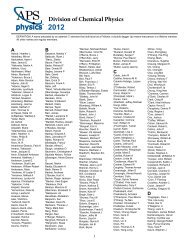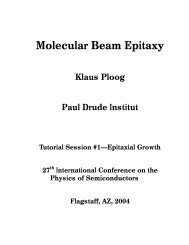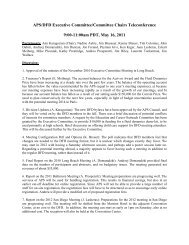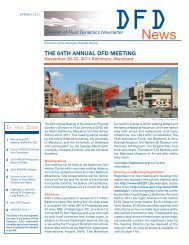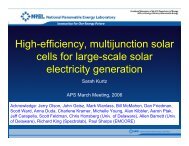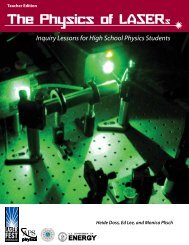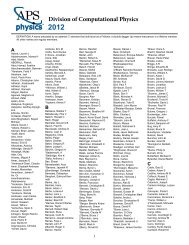SiGe CVD, fundamentals and device applications SiGe CVD ...
SiGe CVD, fundamentals and device applications SiGe CVD ...
SiGe CVD, fundamentals and device applications SiGe CVD ...
You also want an ePaper? Increase the reach of your titles
YUMPU automatically turns print PDFs into web optimized ePapers that Google loves.
<strong>SiGe</strong> <strong>CVD</strong>,<br />
<strong>fundamentals</strong> <strong>and</strong> <strong>device</strong><br />
<strong>applications</strong><br />
Dr Derek Houghton<br />
Aixtron Inc<br />
ICPS, Flagstaff July 2004
� OVERVIEW<br />
1. Introduction<br />
2. <strong>SiGe</strong> Market Survey<br />
3. Fundamentals of <strong>SiGe</strong> <strong>CVD</strong><br />
4. <strong>CVD</strong> Equipment for <strong>SiGe</strong><br />
5. Device aplications <strong>and</strong><br />
commercialization<br />
6. <strong>SiGe</strong> materials engineering, metrology<br />
7. Summary <strong>and</strong> Discussion
<strong>SiGe</strong>’s Market Opportunity...<br />
Si CMOS/BJTs <strong>SiGe</strong> HBTs/CMOS? III-V FETs/HBTs<br />
GSM<br />
DCS<br />
DECT<br />
Automotive<br />
Road<br />
Pricing<br />
Navigation/Areospace<br />
GPS x-b<strong>and</strong><br />
Radar<br />
Communications<br />
ISM<br />
FRA WLAN<br />
OC-48<br />
G-Ethernet<br />
DTH<br />
DBS<br />
OC-192<br />
Collision<br />
Avoidance<br />
WLAN<br />
FRA<br />
LMDS<br />
0.1 0.2 0.5 1 2 5 10 20 50 100<br />
Frequency (GHz)
<strong>SiGe</strong> HBT <strong>device</strong> structure <strong>and</strong> process description<br />
Only difference: Base<br />
<strong>SiGe</strong> replaces Silicon<br />
Key figures of <strong>SiGe</strong> HBT process<br />
• <strong>SiGe</strong> BiCMOS uses <strong>SiGe</strong> HBT + Si<br />
CMOS<br />
• <strong>SiGe</strong> HBT shows same process as<br />
Si BT with exception of 30-80 nm<br />
thin <strong>SiGe</strong> base layer (Ge
<strong>SiGe</strong>‘s main market is telecommunication (wireless <strong>and</strong> datacom)<br />
<strong>SiGe</strong> IC Market [Mio. US$]<br />
1800<br />
1600<br />
1400<br />
1200<br />
1000<br />
800<br />
600<br />
400<br />
200<br />
0<br />
<strong>SiGe</strong> IC forecast by market, 2000 to 2005, in mil. US$<br />
Industrial<br />
Computer<br />
Consumer<br />
Communications<br />
CAGR=+125%<br />
2000 2001 2002 2003 2004<br />
CAGR: Compound Average Growth Rate<br />
YEAR<br />
2005<br />
Comments<br />
• <strong>SiGe</strong> viable alternative to GaAs<br />
• Main markets being targeted:<br />
• Cellular / Cordless / WLAN<br />
• FO-Datacom<br />
(MUX/DEMUX)<br />
• PC interface cards / LAN<br />
• Future trends:<br />
• integrated low power RFfront<br />
end of most h<strong>and</strong>sets<br />
• First choice for up/down<br />
conversion in tuners/<br />
transceivers<br />
• will dominate 40 Gbps<br />
Source: Strategies Unlimited, 1999
Strained Si: prototypes from Intel, IBM & UMC demonstrated<br />
Almost all large Si-CMOS manufacturers are presenting cross sectional pictures of<br />
CMOS transistors (with gate lengths between 65 <strong>and</strong> 90 nm) which use Strained-Si<br />
technology. Intel <strong>and</strong> IBM use their own technology, whereas UMC is Amberwave’s<br />
licensee
Strained-Si HeteroWafer ® technology: process <strong>and</strong> actual status<br />
Actual status Strained-Si process<br />
• Strained Si technology enables improvement<br />
in CMOS performance <strong>and</strong> functionality via<br />
replacement of the bulk, cubic-crystal Si<br />
substrate with a Si substrate that contains a<br />
tetragonally distorted, biaxially strained Si<br />
thin film at the surface<br />
• Different types of processes developed <strong>and</strong><br />
patented by the main players: Amberwave<br />
(IQE) - AIXTRON, IBM,Toshiba & Intel<br />
• First demos of perfect working 52 Mbit<br />
SRAMs with 90 nm CMOS <strong>device</strong>s on 300<br />
mm wafers available from Intel. Ramp-up of<br />
Pentium 4 production with Str.-Si planned for<br />
2H/2003 !<br />
• Process <strong>and</strong> substrate costs still not 100%<br />
fixed. Price expectations for substrate from<br />
IC manufacturers still unknown
Strained Si process of Amberwave: One of the Strained Si pioneers<br />
•Typically, 2 to 4 µm thick graded <strong>SiGe</strong> buffer layer, followed<br />
by thin (
Strained Silicon CMOS technology<br />
*<strong>SiGe</strong> deposited selectively,<br />
Intel Pentium IV in production
Digital CMOS Electronic Market [Mio. US$]<br />
Strained Si based CMOS Market [Mio. US$]<br />
100000<br />
80000<br />
60000<br />
40000<br />
20000<br />
0<br />
100000<br />
80000<br />
60000<br />
40000<br />
20000<br />
Strained silicon mainly addresses high-end digital CMOS markets<br />
Digital electronic market forecast <strong>and</strong> expected strained Si penetration, 2003 to 2007, in mil. US$<br />
CAGR*= 12.5%<br />
CAGR*= 12.5%<br />
2003 2004 2005 2006 2007<br />
Source: VLSI Research, 2002<br />
YEAR<br />
CAGR*= >200%<br />
CAGR*= >200%<br />
0<br />
2003 2004 2005 2006 2007<br />
YEAR<br />
Source: AIXTRON estimates<br />
Si FPGAs<br />
Si Digital Signal Processors (DSPs)<br />
Si Micro-controllers (MCUs)<br />
Si Microprocessors (MPUs)<br />
Assumptions<br />
• Main application will be high-end<br />
Microprocessors like IBM‘s<br />
Power-PC, SUN‘s Sparc, AMD‘s<br />
Athlon, Intel Pentium / Itanium.<br />
• Main markets being targeted:<br />
PCs, workstations, game<br />
consoles, other internet<br />
appliances<br />
• Future trends: Strained Si<br />
penetrates 3G/WLAN wireless<br />
<strong>applications</strong> (DSPs/MCUs)<br />
CAGR: Compound Average Growth Rate
Effect of air exposure prior to HF passivation<br />
Carbon <strong>and</strong> Oxygen concentrations (cm -3 )<br />
10 21<br />
10 20<br />
10 19<br />
10 18<br />
10 17<br />
RCA + 4 hours in air + HF dip<br />
RCA + HF dip<br />
Oxygen<br />
Carbon<br />
0 500 1000 1500 2000 2500 3000 3500<br />
Depth (Å)
Partial pressure for oxygen incorporation from H 2 O <strong>and</strong> O 2
AIXTRON‘s flexible epi systems for Strained Si / <strong>SiGe</strong><br />
Tricent ® vs. Multiwafer Reactor ®<br />
Tricent <strong>SiGe</strong> Cluster Tool: 150, 200 or 300<br />
mm<br />
AIX 2600G3: up to 7x150 or 3x200 mm
Quartz tube<br />
P~ 10 -3 mbar<br />
T g
Hot wall UHV<strong>CVD</strong> Batch tool
Growth Rate<br />
Uniform Gas Distribution by<br />
AIXTRON´s Closed Coupled Showerhead<br />
Horizontal Quarz Tube Reactor<br />
Distance to gas inlet<br />
Closed Coupled Showerhead Reactor<br />
Growth Rate<br />
Distance to gas inlet
Wafer<br />
<strong>SiGe</strong> Tricent ®<br />
Dual-Chamber Showerhead (pat. pend.)<br />
Water-Cooled Reactor Lid<br />
Coated Graphite<br />
Susceptor<br />
Showerhead Detail<br />
N 2 /H 2<br />
Gas Mix<br />
Showerhead<br />
Process<br />
Chamber<br />
T Lid<br />
T SH<br />
T Substr<br />
Temperature Control Concept
<strong>SiGe</strong> Tricent ®<br />
�� Showerhead<br />
�� Temperature control<br />
Unique <strong>CVD</strong> chamber features<br />
developed beyond industry st<strong>and</strong>ards
Tricent ®<br />
Clean<br />
Room Wall<br />
Cassette<br />
Station<br />
Customer Process Support<br />
Process platform for<br />
HBTs, HFETs <strong>and</strong> BiCMOS<br />
- pure Silicon Growth<br />
- differential <strong>SiGe</strong>:C growth<br />
- selective <strong>SiGe</strong>:C growth<br />
- <strong>SiGe</strong> on SOI<br />
Temp Process Gas Sources<br />
550-680°C <strong>SiGe</strong>:C SiH4 + GeH4 + SiCH6<br />
650-750°C <strong>SiGe</strong> SiH4 + GeH4<br />
730-800°C sel. <strong>SiGe</strong> SiH2Cl2 + HCl + GeH4<br />
800-900°C SEG SiH2Cl2 + HCl
<strong>SiGe</strong> HBT in a BiCMOS flow<br />
Metallisation<br />
Spacers<br />
EpitaxialLayer N<br />
MOS<br />
Polysilicon Emitter<br />
LOCOS<br />
n +<br />
HBT<br />
N<br />
+<br />
Base <strong>SiGe</strong>
XTEM of Si deposition on Si/oxide
HBT base structure SIMS profiling<br />
Boron conc. (cm -3 )<br />
10 19<br />
10 18<br />
10 17<br />
10 16<br />
10 15<br />
SIMS analysis (cameca)<br />
Ge<br />
<strong>CVD</strong>-197<br />
0 500 1000<br />
0<br />
1500<br />
Depth (Å)<br />
15<br />
10<br />
5<br />
Germanium conc. (%)
IC, IB (A)<br />
10 -3<br />
10 -5<br />
10 -7<br />
10 -9<br />
10 -11<br />
10 -13<br />
Gummel Plot, npn HBT<br />
Ic<br />
Ib<br />
A = 0.6 x 1.2 micron<br />
E 2<br />
V = 0<br />
CB<br />
V BE (V)<br />
NPN11A, <strong>CVD</strong>-140<br />
Triangular <strong>SiGe</strong> base profile<br />
0 0.2 0.4 0.6 0.8 1 1.2 1.4
CMOS transistor
Selective <strong>SiGe</strong><br />
Epitaxy
DC Houghton J.Appl.Phys.1991
Strained Silicon on<br />
graded <strong>SiGe</strong> buffer<br />
Amberwave<br />
Ge%<br />
Strained Silicon on<br />
SOI wafer by layer<br />
transfer<br />
SOITEC<br />
Strained Si Strained Si<br />
<strong>SiGe</strong> stack<br />
<strong>SiGe</strong> grade<br />
Si substrate<br />
Si substrate
DCD x ray diffraction
Concentration<br />
SIMS profileStrained Si – Graded <strong>SiGe</strong> Buffer<br />
1E+23<br />
1E+22<br />
1E+21<br />
1E+20<br />
1E+19<br />
1E+18<br />
1E+17<br />
Cs Cascade Scientific<br />
12/04/2003<br />
SIMS<br />
70Ge<br />
Sample A3<br />
Low O <strong>and</strong> C background<br />
No Interface peak<br />
12C<br />
interface<br />
16O<br />
29Si+30Si-><br />
1E+16<br />
0 2 4 6<br />
Depth (microns)<br />
8 10<br />
1E+05<br />
1E+04<br />
1E+03<br />
1E+02<br />
1E+01<br />
1E+00<br />
Counts Per Second
Strained Si layers<br />
<strong>SiGe</strong> 40%<br />
<strong>SiGe</strong> graded 5...40%
Pure Ge on Silicon substrates<br />
Low defect density Ge without <strong>SiGe</strong> graded buffer<br />
Ge<br />
Si wafer<br />
Cross sectional TEM<br />
Plan view TEM (looking down<br />
through Ge cap)
Growth Rate vs Germanium concentration<br />
Growth Rate (nm/minute)<br />
12<br />
10<br />
8<br />
6<br />
4<br />
2<br />
0<br />
570°C<br />
525°C<br />
495°C<br />
Rate @ 495°<br />
Rate @ 525°<br />
Rate @ 570°<br />
0 5 10 15 20 25 30 35 40<br />
Ge concentration (%)
Growth rate (nm/minute)<br />
Growth Rates vs Temperature<br />
10<br />
1<br />
600°C<br />
Ea = 1.6 ± 0.1 eV<br />
Si 0.7 Ge 0.3<br />
Reactant Limited<br />
495°C<br />
0.1<br />
1.1 1.15 1.2 1.25 1.3 1.35<br />
Si<br />
1000/T (k -1 )
<strong>SiGe</strong><br />
silicon<br />
<strong>SiGe</strong>/Si Multilayer structure<br />
Abrupt Si/<strong>SiGe</strong> interfaces<br />
<strong>and</strong> precise control<br />
of Ge % for “PIN<br />
Photodetector”
Concentration (Ge %)<br />
20<br />
18<br />
16<br />
14<br />
12<br />
10<br />
8<br />
6<br />
4<br />
2<br />
0<br />
SIMS<br />
<strong>SiGe</strong> Multi Quantum Wells (MQW)<br />
Cs Cascade Scientific<br />
12/04/2003<br />
SIMS<br />
Sample A<br />
0 1000 2000 3000 4000 5000<br />
70Ge<br />
Depth (angstroms)<br />
a5321d_lin.SWF<br />
30Si-><br />
1E+07<br />
1E+06<br />
1E+05<br />
1E+04<br />
1E+03<br />
1E+02<br />
1E+01<br />
1E+00<br />
Counts Per Second
Intensity (cps)<br />
4<br />
A532-1<br />
10<br />
103<br />
102<br />
101<br />
100<br />
10-1<br />
XRD<br />
<strong>SiGe</strong> Multi Quantum Wells (MQW)<br />
Reference (Active) Comparison<br />
• Double crystal X-ray data<br />
• Period of super-lattice = 39.5nm<br />
• Mean Ge fraction of structure<br />
(Si spacers + <strong>SiGe</strong> Wells) = 0.6%<br />
-3000 -2000 -1000 0<br />
th\2th (sec)<br />
1000 2000 3000<br />
Measured by
Raman Scattering
Raman Scattering
Fourier transform low temperature photoluminescence apparatus.<br />
Fourier<br />
Spectrometer<br />
Moving<br />
Mirror<br />
Beamsplitter<br />
Excitation Source<br />
Laser<br />
Cryostat SAMPLE<br />
Germanium<br />
Detector
PL spectra from <strong>SiGe</strong> HBT transistors<br />
Photoluminescence Intensity<br />
Patterned<br />
Wafer<br />
Si Surround<br />
<strong>SiGe</strong><br />
Etched Off<br />
<strong>SiGe</strong><br />
Layer<br />
Vertical<br />
Profile <strong>SiGe</strong><br />
50 nm<br />
900 1000 1100<br />
Energy - meV
<strong>SiGe</strong> PL Peak Height<br />
0.1<br />
0.01<br />
1E-3<br />
PL Intensity<br />
1<br />
PL of <strong>SiGe</strong> HBT<br />
10 15<br />
100<br />
10<br />
<strong>SiGe</strong> PL Threshold &<br />
Saturation Effects<br />
Sample A<br />
As Grown<br />
TO<br />
10 16<br />
PL Spectra<br />
Sample B Annealed<br />
3.5x10 16 s -1 cm -2<br />
1<br />
980 1000 1020 1040 1060<br />
Energy / meV<br />
Si<br />
TA<br />
1.4x10 16 s -1 cm -2<br />
Sample B<br />
Annealed<br />
10 17<br />
Incident Photon Flux / s -1 cm -2<br />
NP<br />
Carrier<br />
Wavefunction<br />
Si<br />
15%<br />
Sample B<br />
As Grown<br />
Ge Profile<br />
10 18<br />
20 nm<br />
<strong>SiGe</strong> - Graded Composition<br />
Si
Sample point "NP" energy<br />
(meV)<br />
Photoluminescence Mapping of<br />
Composition <strong>and</strong> B<strong>and</strong>gap on a 6" wafer<br />
Energy<br />
b<strong>and</strong>gap (meV)<br />
Composition<br />
(% of Ge)<br />
a 1080 1092.2 8.97<br />
b 1082.5 1094.7 8.69<br />
c 1085.2 1097.4 8.39<br />
d 1083.3 1095.5 8.60<br />
e 1082.5 1094.7 8.69<br />
f 1084.8 1097.0 8.44<br />
g 1083.7 1095.9 8.56<br />
h 1079 1091.2 9.08<br />
d c<br />
h<br />
g<br />
f<br />
e<br />
b<br />
a
Auger Electron Spectroscopy<br />
Of Graded germanium concentration profiles<br />
Germanium atomic concentration (%)<br />
20<br />
15<br />
10<br />
5<br />
0<br />
Actual profile<br />
Ideal profile<br />
HBT profile FET profile<br />
0 2000 4000 6000 8000 1 10 4<br />
Sputtering time (s)
Trends in “novel” epitaxy in Si based materials<br />
For graded <strong>SiGe</strong> buffers<br />
Low CoO, defect density reduction, flatness<br />
Thin <strong>SiGe</strong> epitaxy with defect nucleation layer<br />
SOI substrates<br />
Lower thermal budget in CMOS<br />
low leak rate tools<br />
new precursors with high GR at




